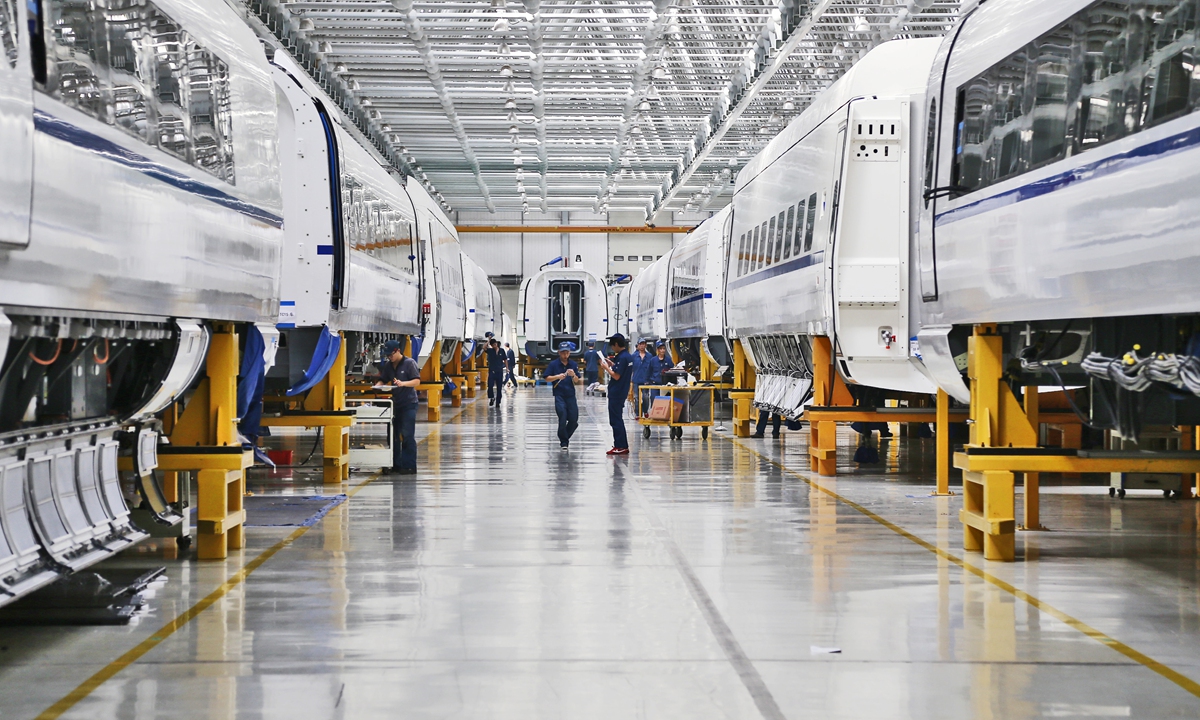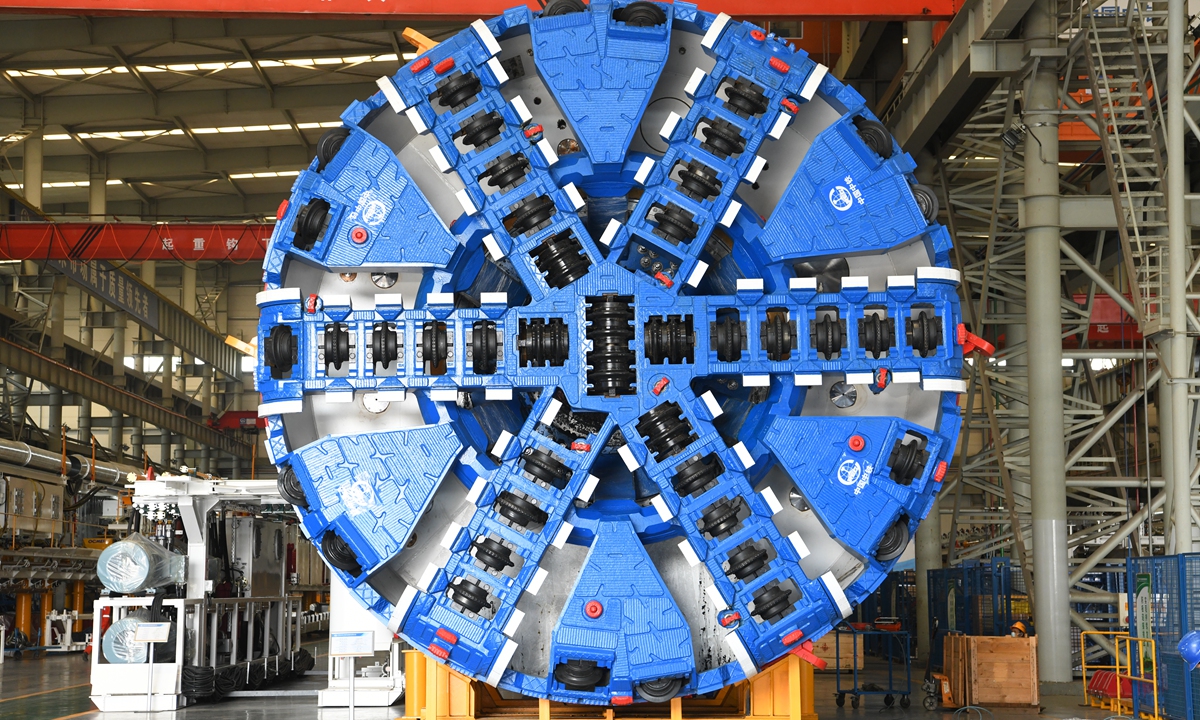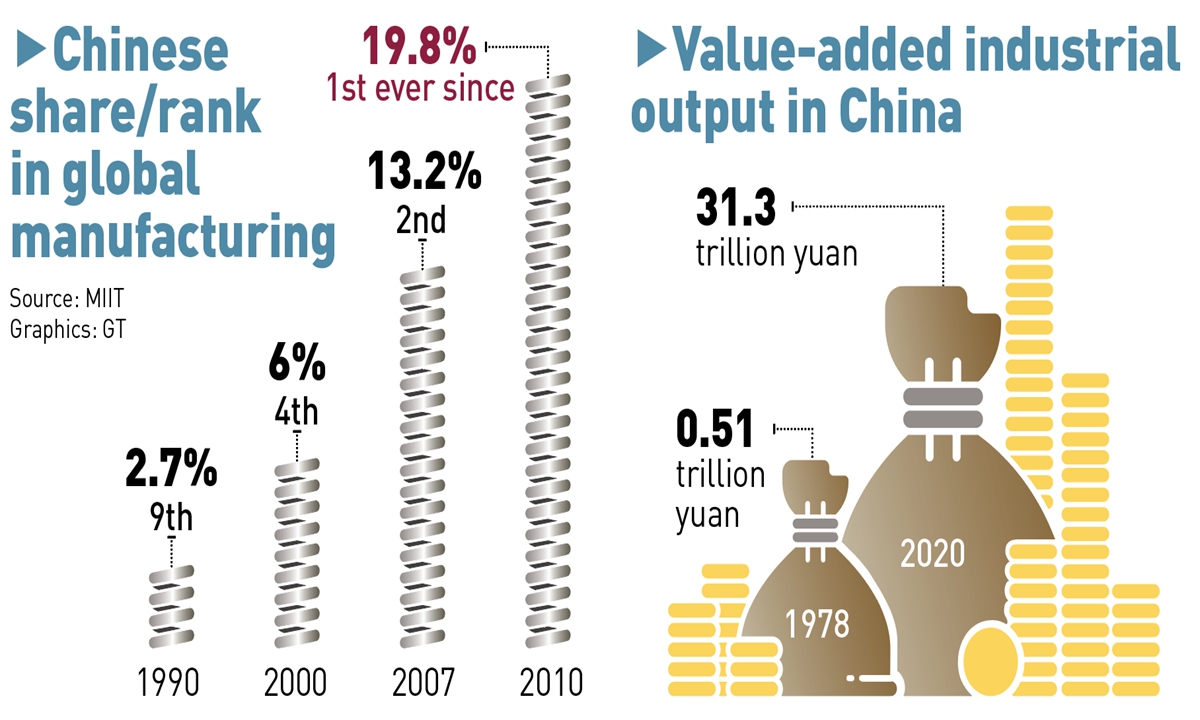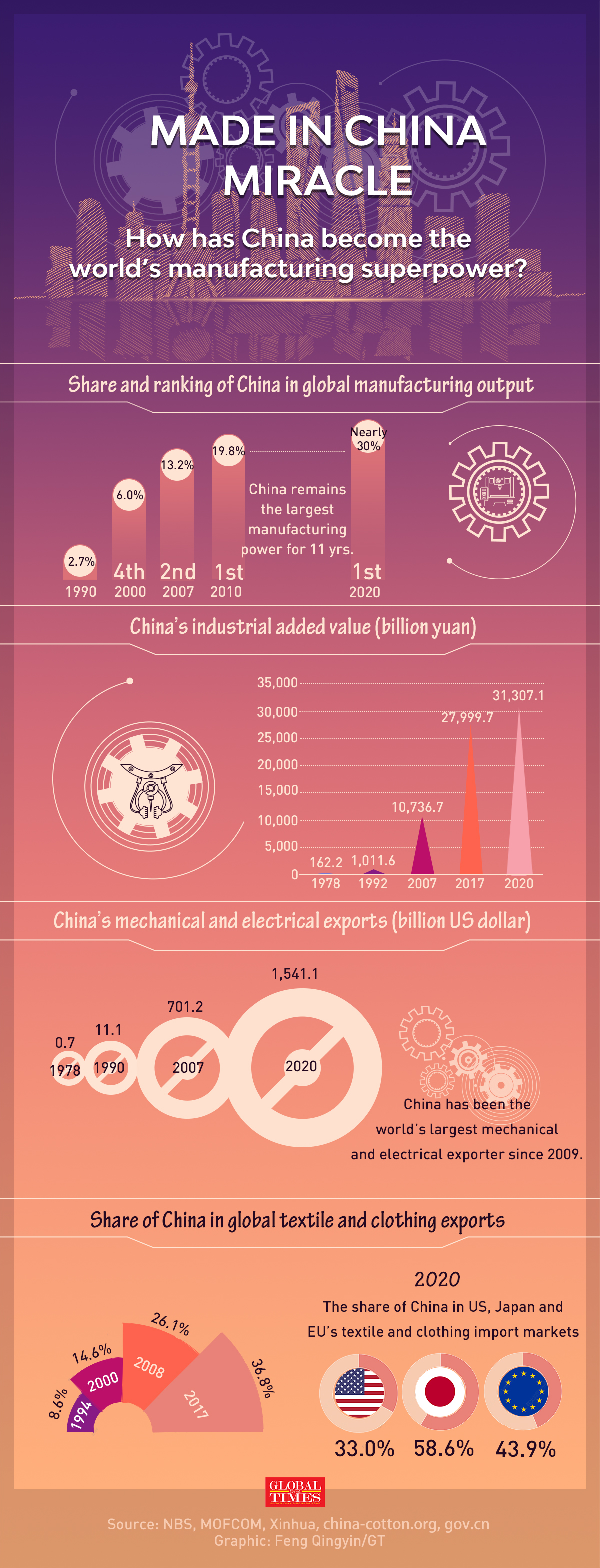
Photo: VCG
Editor's Note:
China on July 1 declared it has reached its first centenary development goal - building a moderately prosperous society, or xiaokang, in all respects, and is marching in confident strides toward the second centenary goal of building China into a great modern socialist country. To decipher what that means in the context of where China is now and where it's heading, the Global Times is publishing a series of multimedia products celebrating the achievements linked to the xiaokang goal in various aspects. This piece focuses on the miracle of China's manufacturing sector that has changed lives at home and abroad.China's status as the world's factory has been known for quite a while, but it has never been clearer than during the COVID-19 pandemic.
To put that into the words of the Governor of the US State of New York Andrew Cuomo: "If you want to talk about lessons learned. We need masks; they are made in China. We need gowns; they are made in China. We need face shields; they are made in China. We need ventilators; they are made in China. We are past that phase. We need testing agents; they are made in China."
Cuomo made that comment in April 2020 when his state, his country and the entire world were in desperate need of life-saving medical supplies which meant they all had to turn to China.
"How? how?" Cuomo asked twice before suggesting that the US' dependence on China was a "national security issue."
Behind that comment is the rapid ascent of China's manufacturing sector over the past several decades, especially since the late 1970s, when building China into a xiaokang society became the overarching goal of the country's social and economic development under the leadership of the Communist Party of China (CPC).
At the centennial of the CPC on July 1, Xi Jinping, general secretary of the CPC Central Committee, declared that China has completed the goal of building the country into a moderately prosperous society in all respects. Under that unparalleled achievement is miraculous progress across a wide range of areas from economic growth to improvement people's livelihood to the rapid rise of the manufacturing sector.
The xiaokang goal contains a sweeping set of objectives covering different areas, but improving the domestic manufacturing capability to ensure the Chinese people's pursuit of a better life both materialistically and spiritually is not only a crucial part of the CPC's people-centered governance but also critical to ensuring a great Chinese rejuvenation.
While China's manufacturing sector has recorded unimaginable progress even three decades ago, tremendous challenges still exist for further upgrading factories and bolstering capabilities to meet demand for even higher-quality and securer supplies - marked by the US' relentless crackdown and technological blockade. But under the CPC's leadership and its robust policymaking and enforcement, and a solid foundation which incorporates world-leading technology, companies and the ingenuity of the Chinese society, China's manufacturing sector is well positioned to reach greater heights, analysts and industry insiders predict.

Photo: VCG
From zero to one
Considering where China's manufacturing capabilities were just four decades ago, compared to where they are today, the progress is nothing short of a miracle.
From being unable to produce nails or a box of matches, to leading in the construction of nuclear power plants and bullet trains, the story of how China grew into the world's factory is fascinating.
"When I was a child, China relied on foreign companies to produce nails, paper and matches," Zhou Shijian, the first generation of college students reared by New China, recalled. "Great strides have been made during the past 70 years."
In 1981 - two years after late Chinese leader Deng Xiaoping first articulated the xiaokang goal - the central government called for the upgrade of China's mass production capability. By 1990, Chinese production of bicycles and television sets was the world's largest.
From this moment onwards, China's manufacturing sector embarked on an unstoppable rise. And the hallmarks of "affluent Chinese families" have also transcended from television sets and refrigerators in the 1980s to "products undefinable" today, as Chinese people's living standards have improved to such a level that people can now dream and buy anything produced in and outside of China.
In 1990, the country's industrial production accounted for 2.7 percent of global output. Yet the country only used a few decades to assert its standing as the world's factory.
In terms of exporting electromechanical products, a key measurement of a country's manufacturing capability, China surpassed Japan in 2006, trailing only Germany and the US. In 2008, China overtook the US and in 2009 China surpassed Germany for the first time, ranking first in the world. Since then, China has remained the world's No.1 exporter of electromechanical products for an unbroken 12 year stretch.
According to data from the United Nations and the Chinese central government, China has been the world's biggest manufacturer since 2010, with 31.3 trillion yuan ($4.8 trillion) in industrial added value in 2020. This accounts for nearly 30 percent of global manufacturing output - or roughly the same as the combined share of the US, Japan and Germany.
In the 2020 edition of Competitive Industrial Performance Report, released by the UN Industrial Development Organization on 152 countries and regions, China ranked second, trailing Germany but ahead of South Korea and the US. The report showed that China's ranking steadily improved since 1990.
Cao Heping, an economist at Peking University, told the Global Times that a relatively sound industrial foundation laid out since the 1950s, the ingenuity of the Chinese people, industrial policies providing continuity, and an education system focused on improving the literacy of the masses made the explosive growth of China's manufacturing sector possible.
CPC's vision on seeing manufacturing as the foundation of China's growth and stability, and its capability in implementing its industrial policy in a continual fashion, have proved indispensable to China's miracle in manufacturing, analysts pointed out.

Photo: VCG
Chinese ingenuityUsing homegrown components to replace expensive foreign imports gave an extra edge to Chinese manufacturing - a price advantage enforced by the fact that China possesses a complete industrial ecosystem and supply chain. That allows the world's factory to churn out low-cost, high-quality goods and products.
When Beijing-based BOE Technology acquired Hyundai's LCD business in 2003, few had anticipated that the Chinese company will one day dominate the vitally important global display panel industry. When BOE rolled out its offerings, at two-thirds the price of global brands, Japanese and South Korean LCD makers had to lower their prices to meet the market.
Today, BOE is the world's largest producer of display panels accounting for one-fifth of global display panel production. And its development has brought down the costs for China's high-tech industries from TV to mobile phones.
Under the CPC's stewardship, which has pushed for improving the quality of manufacturing sector, the development of the Chinese manufacturing has steadily moved toward high-quality development.
The three-decade-long and ongoing story of Foxconn in China offers a case study.
Setting up its first plant in the Chinese mainland in 1988, Foxconn now owns six plants across the mainland employing 1 million workers, producing sophisticated electronic devices like iPhone.
Having come to the mainland in search of cheap labor in its initial years, the company's strategy evolved over the years as the average wage of local workers went higher and higher. Now, the company aims to become an artificial intelligence-empowered platform, rather than just an OEM.
Today, Chinese manufacturing is undergoing a wholesale transformation toward smart and green technology.
At Shangdong Port Group Qingdao Port's automated container terminal, the Global Times had a preview of China's manufacturing power in the next stage of its economic development. The port, incorporating the most advanced automation technology and boasting the fastest handling efficiency in the world, had fleets of autonomous guided vehicles that work seamlessly with AI-directed cranes, which lift containers with unmatched efficiency.
The terminal utilizes hydrogen energy and 5G wireless technology, handles 36.2 standard containers per hour on average and reduces carbon dioxide emissions by 3.5 kilograms for each container handled. The traditional dependency on the skills and dexterity of workers operating 50 meters in the air is a thing of the past.
Qingdao, which in July debuted the world's first 600-kilometer-per-hour maglev train and produces 60 percent of the country's bullet train fleet, is just one out of many that are embarking on the endeavor of scaling up the technological scene and moving up the value chain.
In its 14th Five-Year Plan, Shanghai laid out a vision to build itself into a world-class chip hub by 2025. Shenzhen, the Southern manufacturing powerhouse, aims to groom 50 national-level manufacturing champions and over 10 Global Top 500 firms by 2025.
The central government, meanwhile, is attaching great importance to the development of the manufacturing industry, adhering to the innovation-driven development strategy, and taking the promotion of high-quality manufacturing development as an important gripper in building a modernized economy.
All these efforts are rooted in the firm belief that manufacturing is the foundation of the country.

Graphics: GT
Economy of scaleChinese manufacturing sector's immense scale and its ability to upgrade its production in a short time as well as adapting to market trends reflect the strength of "Made in China."
In 2001, China's accession to the WTO brought immense opportunities to tens of thousands of manufacturing firms in the country. The world's factory began to hum.
"By opening up its domestic market, China, in exchange, gained access to the market of 147 countries and regions," Zhou said. That number later grew to 164. "The cheap and cheerful 'Made in China' finally got the opportunity to display its skill to the fullest."
The World Cup, a gathering of world's soccer fans every four years, bore witness to China's growing manufacturing prowess.
"Made in China" began to signal its strength at the South Africa World Cup in 2010. A loud, meter-long trumpet called Vuvuzela dominated World Cup stadiums. Nine out of 10 Vuvuzelas were shipped from Yiwu in East China's Zhejiang Province, later dubbed the world's capital of small commodities.
Then, in 2014, at the Brazil World Cup, it seemed that China has fully arrived. Chinese companies that year churned out so wide an array of miscellaneous goods including caps, flags, sunglasses, wigs, mascots, trumpets, condoms and binoculars that "Made in China" became omnipresent.
Each year, Chinese manufacturers' ability to quickly scale up production and swiftly adapt to the ever-changing demand grew.
That ability has grown to such a state that in 2016, Yao Dandan, a flag-making plant owner based in Yiwu, went on to claim that Donald Trump was winning the US election that year, having drawn conclusion from the orders placed by US merchants during election events.
That capacity is backed by China's vast force of small business and manufacturing enterprise. In 2020, the GDP of Yiwu, where 13,000 foreign businesspeople from over 80 countries and regions reside permanently, was 1,161 times of its 1978 level.
Yet Yiwu is not alone. Today, many Chinese localities specializing in the production of certain products or goods have become the world's capitals in their own sense.
Smaller cities and towns could be world manufacturers that produce everything around people's daily life. The town of Pingdu in East China's Shandong Province, where a cluster of over 860 manufacturers produce false eyelashes, supply about 70 percent of world demand. Xuchang in Central China's Henan Province, which is dubbed "the world's wig capital," supplies more than half of the global wig demand. Anji in East China's Zhejiang Province produces one third of the swivel chairs in China and one half of exported swivel chairs.
Today, a growing list of China's new industrial champions, from telecom gear giant Huawei and electronics maker Xiaomi to drone maker DJI and automaker Geely, is reshaping world's opinion toward China's manufacturing sector with the growing contribution of the high-tech elements.

Photo: VCG
Path to greater heights
Time has come for China to turn its economy of scale, economy of scope toward an innovation-led growth.
In the new journey to fully build a modern socialist China by the middle of the century - the 100th birthday of the People's Republic of China, the CPC leadership has set the goals of achieving socialist modernization by 2035.
Aware of the vital role the manufacturing sector has to play in that vision, the CPC leadership devoted an entire chapter of its 14th Five-Year Plan (2021-25) and Long-Range Objectives Through to the Year 2035 emphasizing the importance on deepening the implementation on building the country into a strong manufacturing power.
The adaptation toward digitalization and a shift toward intelligent manufacturing, tackling bottlenecks in both hardware and software, are set to become leading features of China's manufacturing upgrade, analysts said.
Cao said that by that time the development of manufacturing industries empowered by digital technologies will be "explosive," noting that the current level of applications of digital technologies is only the "tip of an iceberg" of the immense progress to be seen in the coming decades.
Zhou stressed that Chinese manufacturing's weakness in foundational areas such as basic parts, materials and technologies have to be addressed before the world's factory can restructure itself.
The Chinese government is taking a coolheaded approach with regard to the outlook for the manufacturing sector with a former top official overseeing China's industrial development declaring that it will take at least 30 years for the country to become a top manufacturing power like the US or Germany while identifying China only as in the third echelon inside a four-tier ranking.
According to this ranking, the US, Germany and Switzerland were in the top tier, whereas Japan, South Korea, France and Singapore sit in the second tier.
Amid mounting uncertainty and flare up of geopolitical tensions, China's manufacturing sector's next-phase growth will center on smart manufacturing and intelligent manufacturing underpinned by world leading engineering and scientific talent, pivoting from its current comparative advantages in cost and scale, analysts have said. To that end, reforms in the education, technical training will be needed and research & development input leveled up.
Cao said to navigate the new frontiers of manufacturing in the new age, the country still needs to set up a complete innovation chain that includes IPR protection, recognition for technical skills and high value workers, combined with the reimagining of training for a new type of labor force.

CPC's vision, Chinese ingenuity underpin manufacturing prowess as foundation of China's growth and stability. Graphic:Feng Qingyin/GT









